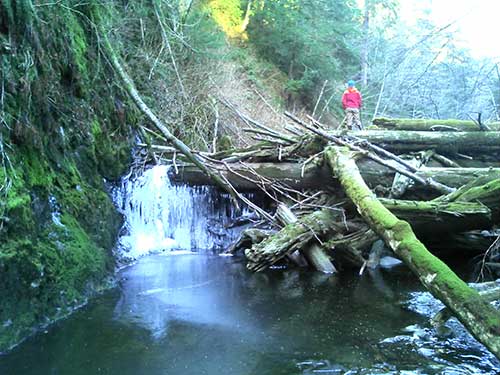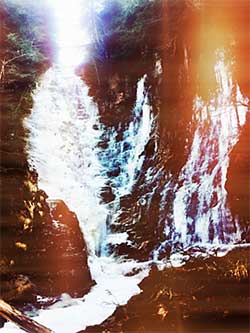Alaska Fish & Wildlife News
March 2014
Steep Water
How to Measure a Waterfall

Your alarm gently chirps at you to wake up, and you crawl out of bed as cheerfully as a cat in a bathtub. The air outside is a frigid shade of blue, and snowflakes gather in the glow of the streetlights as if they’re trying to stay warm. The hands of the clock climb slowly up the face from six-thirty. You open the door of your bunkhouse bedroom, pad downstairs in your socks, and pour yourself a cup of coffee from a pot landscaped with eons of mediocre black tar petrol. Back upstairs you pull on a pair of the ubiquitous faded orange canvas pants stained with paint, tree sap, and grease. Pine needles tumble from the rolled-up cuffs. The only things that get better with age are Carhartts, scotch, and lasagna.
You pack the day’s meal of rice, hummus, and yellow peppers swaddled in a wrap, and cram it into a Tupperware container. Also tossed in the sack are Tree Top fruit gummies, chocolate-chip-chocolate-dipped granola bars, and a bottle of water. Your crewmate Rick is pulling on stiff waders and lacing up his boots. Strapping into your pink and black chest pack requires the flexibility of a yogi. You lurch around, whimpering, reaching up behind your back to retrieve a twisted strap, looking as though you’re about to cry Uncle to some invisible bully after your lunch money.
It has snowed at least eight inches overnight. Feathery, dry flakes drift lazily about, covering the landscape in a dusting of powdered sugar. You think to yourself that if life had a texture, this would have to be it.
Walking streams is a delight in the winter. The world is quiet. Rushing rapids become a burbling mumble encased in ice. The woods are softer, and prints give away the movement of winter’s creatures. You kneel to examine wolf tracks traversing the riverbank and glance around, hoping with all your heart to see that spirit-like figure loping through the trees. Suddenly a whisper seems too loud.

You are searching for something on this halcyon river. Something whose might betrays it in the summer, but is subdued in the winter. Something that is cloaked like a frozen secret, with only glimpses of the power beneath. You are searching for a waterfall. Your job is to put aside your awe (and the tugging urge to climb around on it) and harness its beautiful brawn into numbers.
Fumbling with the Velcro on your chest pack, you pull out your GPS, inclinometer, laser rangefinder, and notebook. Rick picks his way around the falls to stand at the water’s surface at the top. You gingerly step onto the ice, put the rangefinder to your eye and shoot your distance from the falls, focusing on a log or patch of rock at your eye level. The unit reads 15 meters. You convert that to feet using your trusty pink iPhone (oh, the humanity). After scribbling 45’ in your notebook, you shoot the gradient in percent using your inclinometer. The base of the falls reads a negative 10 percent, and aiming to Rick’s shoulder (your eye level), you read a positive 35 percent. Rick climbs back down and the two of you sit on the bank to do the math. Let’s see….35 – (-10) = .45 gives you the gradient of the falls in percent. You multiply that number by your distance of 45 feet and the result is the height of the falls at 20.25 feet.
You look up at the frozen sculpture and try to imagine a two-story building next to it. There is no jump pool at the base, no mellow channels for fish to scoot around. It is bedrock, and the textbook barrier to fish passage. The chart you refer to announces that a “blockage may be presumed if a fall height in feet exceeds:” four feet for pink and chum, eleven for coho, ten for sockeye, and thirteen feet for the mighty and elusive steelhead[i]. Rick points out the vegetation line that is carved out by high water.

“I bet this thing rages in the spring,” he comments. You nod; your mouth is full of celebratory gummy snacks.
They say that if you shout at the northern lights, their glowing waves intensify. You have stood in the roaring spray at the base of a waterfall in the heat of the summer, tilted your face up to it, and hollered at the top of your lungs. The only thing it did was pull the cry from your body. You decide that no matter what the measure of a waterfall is, it will always take your breath away.
Tess Quinn is a fish and wildlife field technician for the Habitat division, and documents anadromous fish streams to update the Anadromous Waters Catalog. She is continuing her fieldwork in the frozen north, cataloguing streams in the off-season.
[i] Anadromous Fish Block guide from the Alaska Forest Resources & Practices Regulations handbook, 2007, 11 AAC 95.265.
Subscribe to be notified about new issues
Receive a monthly notice about new issues and articles.
